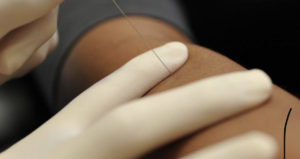

CORE Physical Therapy In Omaha Explains…
By Dr. Mark Rathjen PT DPT CSCS
CORE Physical Therapy Co-owner
17660 Wright street sites 9/10
Omaha NE
402-933-4027
The cited below article summarizes…
“Low to moderate evidence suggests that dry needling can be effective for improving pain intensity and pain-related disability in individuals with neck pain symptoms associated with TrPs at the short-term. “
Although not as definitive as we see here at CORE in a more clinical setting, we do see good efficacy with dry needling in certain situations. 28 trials were examined during the meta analysis. A meta analysis is a literature review and analysis of the studies regarding one topic in the area of research.
We do see clinically with dry needling is a great short term solution to stabilize the body into a more neutral resting state, which allows us to fix issues that arise in a more efficient and timely manner. Dry needling itself is not really designed to solve any issues.
At CORE Physical Therapy in Omaha, we are training in trigger point dry needling from the Myo-pain institute. As the years have gone by we have modified our own style of Dry needling tailored for the athlete. We regularly treat and dry needle more than 4000 patients per year. Our results in the last decade have been astounding.
At CORE Physical Therapy in Omaha, We specialize in the treatment of athletes. We have worked with athletes for a combined 30 years. CORE was established in 2015 by Dr. Mark and Dr. Claire Rathjen is family owned and operated.
We are proud to serve the greater Omaha metro area.
For More information, Please feel free to contact us http://coreomaha.com/contact/
Please feel free to follow us at https://www.facebook.com/COREomaha/
To get started http://coreomaha.com/getting-started/
For more Blog information http://coreomaha.com/blog/
Youtube Account linked below.
https://www.youtube.com/channel/UCVg8OSN5h-i1n_ykw1Gvahg?view_as=subscriber
Effectiveness of Dry Needling for Myofascial Trigger Points Associated with Neck Pain Symptoms: An Updated Systematic Review and Meta-Analysis
- PMID: 33066556
- PMCID: PMC7602246
- DOI: 10.3390/jcm9103300
Free PMC article
Abstract
Our aim was to evaluate the effect of dry needling alone as compared to sham needling, no intervention, or other physical interventions applied over trigger points (TrPs) related with neck pain symptoms. Randomized controlled trials including one group receiving dry needling for TrPs associated with neck pain were identified in electronic databases. Outcomes included pain intensity, pain-related disability, pressure pain thresholds, and cervical range of motion. The Cochrane risk of bias tool and the Physiotherapy Evidence Database (PEDro) score were used to assessed risk of bias (RoB) and methodological quality of the trials. The quality of evidence was assessed by using the Grading of Recommendations Assessment, Development, and Evaluation (GRADE) approach. Between-groups mean differences (MD) and standardized mean differences (SMD) were calculated (3) Twenty-eight trials were finally included. Dry needling reduced pain immediately after (MD -1.53, 95% CI -2.29 to -0.76) and at short-term (MD -2.31, 95% CI -3.64 to -0.99) when compared with sham/placebo/waiting list/other form of dry needling and, also, at short-term (MD -0.51, 95% CI -0.95 to -0.06) compared with manual therapy. No differences in comparison with other physical therapy interventions were observed. An effect on pain-related disability at the short-term was found when comparing dry needing with sham/placebo/waiting list/other form of dry needling (SMD -0.87, 95% CI -1.60 to -0.14) but not with manual therapy or other interventions. Dry needling was effective for improving pressure pain thresholds immediately after the intervention (MD 55.48 kPa, 95% CI 27.03 to 83.93). No effect on cervical range of motion of dry needling against either comparative group was found. No between-treatment effect was observed in any outcome at mid-term. Low to moderate evidence suggests that dry needling can be effective for improving pain intensity and pain-related disability in individuals with neck pain symptoms associated with TrPs at the short-term. No significant effects on pressure pain sensitivity or cervical range of motion were observed. Registration number: OSF Registry-https://doi.org/10.17605/OSF.IO/P2UWD.
Keywords: cervical spine; dry needling; meta-analysis; neck pain; systematic review.
